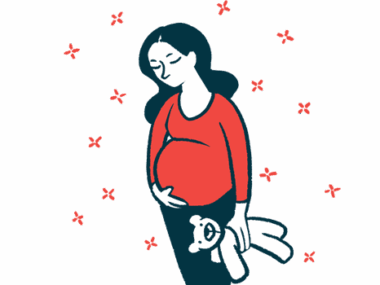Women maintain Cimzia blood levels throughout pregnancy
Levels for those with axSpA similar to nonpregnant people: CHERISH trial data
Written by |

Women with axial spondyloarthritis (axSpA) or other inflammatory diseases maintained stable therapeutic levels of Cimzia (certolizumab pegol) throughout pregnancy, as announced by UCB, the therapy’s developer.
The results, from the open-label Phase 1b CHERISH clinical trial (NCT04163016), were presented at the European Congress of Rheumatology held June 12-15 in Vienna.
“Women of childbearing age living with chronic immune-mediated diseases are understandably concerned about how to ensure adequate disease control throughout pregnancy while preventing or minimizing exposure for their baby,” Emmanuel Caeymaex, UCB’s executive vice president, head of patient impact, and chief commercial officer, said in a company press release. “Through CHERISH and the full body of evidence we have built, we are equipping women and healthcare professionals with the data they need to make informed, personalized decisions around treatment continuation during family planning, pregnancy and breastfeeding.”
AxSpA is a form of chronic arthritis that mainly affects the joints of the spine and the sacroiliac joints, where the base of the spine meets the pelvis. Ankylosing spondylitis is an axSpA subtype characterized by joint damage visible on an X-ray, in contrast with nonradiographic axSpA where no such damage is visible.
Symptoms include chronic pain, stiffness, and fatigue, as well as limited spinal mobility and physical function.
Cimzia is an engineered antibody fragment approved to treat adults with inflammatory conditions, including AS. It works by blocking tumor necrosis factor alpha, or TNF-alpha, a pro-inflammatory signaling protein, reducing inflammation.
CHERISH clinical trial included 21 pregnant women
In clinical trials, the treatment was found to reduce joint swelling, pain, and fatigue, as well as to improve the patient’s physical function. The CHERISH trial tested Cimzia in pregnant women with chronic inflammatory diseases, including AxSpA, psoriatic arthritis, and rheumatoid arthritis.
The study included 21 participants, with a mean age of 32.2 years. They had been pregnant for up to 10 weeks at the time of enrollment, and on a stable Cimzia dose for at least 12 weeks (about three months). Most patients (76.2%, 16 women) completed the study.
Most women were receiving the treatment at a dose of 200 mg every two weeks, whereas one received 400 mg every two weeks, and five 400 mg every four weeks.
The study’s main goal was to assess the treatment pharmacokinetics — its movement into, through, and out of the body — by collecting participants’ blood samples every four weeks before treatment, seven days after Cimzia administration every eight weeks, and also after delivery.
Results show the range of Cimzia blood levels was similar to that observed in studies with nonpregnant participants with axSpA, or other inflammatory conditions such as psoriatic or rheumatoid arthritis (1.7-45.3 micrograms/mL). Cimzia levels remained consistent through pregnancy.
Blood levels of Cimzia were lower during pregnancy than after the infant was born. These differences were reduced when considering each participant’s blood levels of albumin, the most abundant protein in blood plasma, and body mass index — a measure of body fat based on weight and height — but not C-reactive protein, a marker of inflammation.
Safety data were consistent with the known safety profile of Cimzia. Most patients (81%) had one treatment-emergent adverse event (meaning a side effect that started or worsening with treatment), most frequently (57%) infections and infestations — diseases caused by parasites — with no deaths or infant illnesses reported.
“This suggests that [pregnant women] may remain on their dosing regimen during pregnancy, particularly as [Cimzia] has been shown to minimally cross the placental barrier, to ensure stable plasma concentration throughout pregnancy,” the researchers wrote.
Overall, these data build on previous pharmacokinetic studies that showed little to no Cimzia transfer from mother to baby through the placenta or breast milk.
“The new clinical data … are valuable to support more personalized treatment that is tailored to the individual needs, lifestyle choices and clinical profile of each patient,” said Oseme Etomi, consultant rheumatologist and obstetric physician at Guy’s and St Thomas Hospitals, London.






